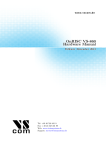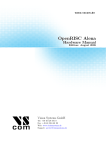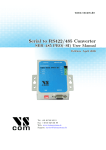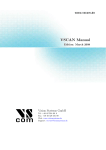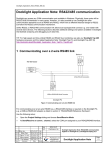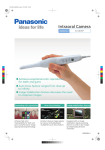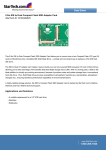Download OnRISC OnRISC Alekto and Alekto LAN Alekto and Alekto
Transcript
www.vscom.de OnRISC OnRISC Alekto Alekto and and Alekto Alekto LAN LAN Hardware Hardware Manual Manual Edition: June 2013 Vision Systems GmbH Tel: +49 40 528 401 0 Fax: +49 40 528 401 99 Web: www.visionsystems.de Support: faq.visionsystems.de The software described in this manual is furnished under a license agreement and may be used only in accordance with the terms of that agreement. Copyright Notice Copyright © 2009-2013 Vision Systems. All rights reserved. Reproduction without permission is prohibited. Trademarks VScom is a registered trademark of Vision Systems GmbH. All other trademarks and brands are property of their rightful owners. Disclaimer Vision Systems reserves the right to make changes and improvements to its product without providing notice. Vision Systems provides this document “as is”, without warranty of any kind, either expressed or implied, including, but not limited to, its particular purpose. Vision Systems reserves the right to make improvements and/or changes to this manual, or to the products and/or the programs described in this manual, at any time. Information provided in this manual is intended to be accurate and reliable. However, Vision Systems assumes no responsibility for its use, or for any infringements on the rights of third parties that may result from its use. This product might include unintentional technical or typographical errors. Changes are periodically made to the information herein to correct such errors, and these changes are incorporated into new editions of the publication. Version 1.0 OnRISC Hardware Manual 2 Contents Contents 1 Overview 1.1 Product Features . . . . 1.2 Hardware Specifications 1.2.1 System . . . . . 1.2.2 Serial Ports . . . 1.2.3 Digital I/O . . . 2 Position of Connectors and 2.1 LEDs . . . . . . . . . 2.2 Reset Button . . . . . 2.3 WLAN On/Off Button . . . . . 5 5 6 6 7 7 Functions . . . . . . . . . . . . . . . . . . . . . . . . . . . . . . . . . . . . . . . . . . . . . . . . . . . . . . . . . . . . . . . . . . . . . . (Alekto LAN Only) . . . . . . . . . . . . . . . . . . . . . . . 7 7 7 8 . . . . . . . . . . . . . . . . . . . . . . . . . . . . . . . . . . . . . . . . . . . . . . . . . . . . . . . . . . . . . . . . . . . . . . . . . . . . . . . . . . . . . . . . . . . . . . . . . . . . . . . . . . . . . . . . . . . . . . . . . . . . . . . . . . . . . . . . . . . . . . . . . . . . . . . . . . . . . . . . . . . . . 3 Dimensions 10 3.1 Alekto . . . . . . . . . . . . . . . . . . . . . . . . . . . . . . . . . . . . . . . . . . . . 10 3.2 Alekto LAN . . . . . . . . . . . . . . . . . . . . . . . . . . . . . . . . . . . . . . . . . 11 4 Connectors 4.1 Power . . . . 4.2 Grounding . . 4.3 LAN . . . . . 4.4 Console Port 4.5 CF-Slot . . . 4.6 Serial . . . . 4.7 microSD-Slot 4.8 USB . . . . . 4.9 I2C . . . . . . 4.10 Digital I/O . . . . . . . . . . . . . . . . . . . . . . . . . . . . . . . . . . . . . . . . . . . . . . . . . . . . . . . . . . . . . . . . . . . . . . . . . . . . . . . . . . . . . . . . . . . . . . . . . . . . . . . . . . . . . . . . . . . . . . . . . . . . . . . . . . . . . . . . . . . . . . . . . . . . . . . . . . . . . . . . . . . . . . . . . . . . . . . . . . . . . . . . . . . . . . . . . . . . . . . . . . . . . . . . . . . . . . . . . . . . . . . . . . . . . . . . . . . . . . . . . . . . . . . . . . . . . . . . . . . . . . . . . . . . . . . . . . . . . . . . . . . . . . . . . . . . . . . . . . . . . . . . . . . . . . . 12 12 12 12 12 12 13 13 13 13 14 5 Internal Components 5.1 Serial Port Jumper Block . . . 5.1.1 Termination Resistors . 5.1.2 BIAS Function . . . . . 5.2 Internal Flash Write Protection 5.3 UMTS/LTE (3G/4G) . . . . . 5.4 SIM Card . . . . . . . . . . . . 5.5 Battery . . . . . . . . . . . . . . . . . . . . . . . . . . . . . . . . . . . . . . . . . . . . . . . . . . . . . . . . . . . . . . . . . . . . . . . . . . . . . . . . . . . . . . . . . . . . . . . . . . . . . . . . . . . . . . . . . . . . . . . . . . . . . . . . . . . . . . . . . . . . . . . . . . . . . . . . . . . . . . . . . . . . . . . . . . . . . . . . . . . . . . . . . . . . . . . . . . . . . . . . . . . . . . . . . . . . . . . . . . . . . . . 15 15 15 15 15 16 16 16 . . . . . . . . . . . . . . . . . . . . . . . . . . . . . . . . . . . . . . . . . . . . . . . . . . . . . . . . . . . . . . . . . . . . . . . . . . . . . . . . . . . . . . . . . . 6 Product Support Information 17 List of Figures 1 2 3 4 5 6 Appearance Alekto Appearance Alekto Case Alekto . . . . Case Alekto LAN . Terminal Resistors WP Jumper . . . . Version 1.0 . . . LAN . . . . . . . . . . . . . . . . . . . . . . . . . . . . . . . . . . . . . . . . . . . . . . . . . . . . . . . . . . . . . . . . . . . . . . . . . . . . . . . . . . . . . . . . . . . . . . . . . . . . . . . . . . . . OnRISC Hardware Manual . . . . . . . . . . . . . . . . . . . . . . . . . . . . . . . . . . . . . . . . . . . . . . . . . . . . . . . . . . . . . . . . . . . . . . . . . . . . . . . . . . . . . . . . . . . . . . . . . . . . . . . . . . . . 8 9 10 11 15 16 3 List of Tables List of Tables 1 2 3 4 5 6 Product Hardware Specifications . . . Serial Interface Specifications . . . . . LED Indicators . . . . . . . . . . . . . DSUB Pinout . . . . . . . . . . . . . . Digital I/O: Electrical Characteristics RS422/485 Jumper Configuration . . . Version 1.0 . . . . . . . . . . . . . . . . . . . . . . . . . . . . . . . . . . . . . . . . . . . . . . . . OnRISC Hardware Manual . . . . . . . . . . . . . . . . . . . . . . . . . . . . . . . . . . . . . . . . . . . . . . . . . . . . . . . . . . . . . . . . . . . . . . . . . . . . . . . . . . . . . . . . . . . . . . . . . . . . . . . 6 . 7 . 7 . 13 . 14 . 15 4 1 Overview 1 Overview The OnRISC is an ARM9-based RISC industrial embedded computer. The great variety of interfaces like LAN, CF, USB, I2C, serial interface and digital I/O makes it easy to connect various industrial devices to the OnRISC. Compact dimensions and DIN Rail mounting capability make the OnRISC to a space saving and flexible mounting industrial computer. It is feasible to be installed even in space limited environments. Due to RISC based architecture the OnRISC has very small power consumption (6,5 Watt), so fanless heat dissipation is possible. Working in an extended temperature range from -10°C up to 65°C the OnRISC can be used under harsh industrial conditions. Therefore the OnRISC is downright designed for industrial automation. 1.1 Product Features • ARM9 32-bit RISC CPU, 166MHz • 64MB SDRAM on board • 4MB Flash on board • up to 2 x RS232/RS422/RS485 serial ports • 8 independent digital I/O channels • 1 x CF-Slot in True IDE mode (accepts Microdrives) • 1 x microSD-Slot • 2 x USB 2.0 as Host • MiniPCI-slot for expansion with WLAN, GPS etc. • 2 x Ethernet interfaces for redundant networking or routing functions (Alekto) • 1 x Ethernet interface with quad LAN switch (Alekto LAN) • WLAN on/off button (Alekto LAN) • I2C bus with max. 330kHz clock • RTC • Ready-to-Run Debian Linux for ARM operating system • DIN-Rail and wall-mount installation • Robust, fanless design • Wide temperature range -10 to 65°C • Buzzer, Watch Dog Timer • WLAN on/off button (Alekto LAN) Version 1.0 OnRISC Hardware Manual 5 1.2 1.2.1 System CPU RAM Flash CF-Slot microSD-Slot USB OnRISC Hardware Manual LAN Serial Ports Digital I/O Console Port I2C RTC Buzzer Watch Dog Timer MiniPCI-Slot Reset Button WLAN On/Off Button Power Input Power Consumption Dimensions (W x L x H) OnRISC Alekto ARM9 32-bit RISC CPU, 166MHz 64MB SDRAM 4MB True IDE mode (accepts Microdrives) 1 x internal 2 x 2.0 as Host (external) 2 x 2.0 as Host (internal) 10baseT/100baseTX Autodetect and Auto-MDI(X) 2 x RS232/RS422/RS485 up to 3.6Mbps 8 x input/output signals (32 mA max.) RS232, up to 115200bps max. 330kHz yes yes yes yes HW Reset, long hold to access BIOS via Telnet 9-30V DC max. 1.5A @ 12V 157 x 106 x 53 mm 157 x 112 x 53 mm with DB9 connector OnRISC Alekto LAN ARM9 32-bit RISC CPU, 166MHz 64MB SDRAM 4MB True IDE mode (accepts Microdrives) 1 x internal 2 x 2.0 as Host (external) 1 x 2.0 as Host (internal) 10baseT/100baseTX Autodetect and Auto-MDI(X) 1 x RS232/RS422/RS485 up to 3.6Mbps 8 x input/output signals (32 mA max.) RS232, up to 115200bps max. 330kHz yes yes yes yes HW Reset, long hold to access BIOS via Telnet 1x 9-30V DC max. 1.5A @ 12V 157 x 106 x 53 mm 157 x 112 x 53 mm with DB9 connector Table 1: Product Hardware Specifications Hardware Specifications Version 1.0 1.2 Hardware Specifications 6 2 Position of Connectors and Functions 1.2.2 Serial Ports Up to two serial ports are provided in RS232/422/485 modes that can be switched by software (Alekto - 2 serial ports, Alekto LAN - 1 serial port). For the detailed information about the supported modes refer to the Table 2. Modes Signals Data Direction Control Speed RS232 full duplex RS422 full duplex TxD, RxD, RTS, CTS, DTR, DSR, DCD, RI, GND Tx+/-, Rx+/-, GND up to 921.6 Kbps up to 3.6 Mbps RS485 2-wire: half duplex, with echo 2-wire: half duplex, without echo 4-wire: full duplex 2-wire: Data+/-, GND 4-wire: Tx+/-, Rx+/-, GND by ART (Automatic Receive Transmit control) or by RTS up to 3.6 Mbps Table 2: Serial Interface Specifications 1.2.3 Digital I/O Eight input/output signals at TTL level are provided. The signal direction is individually configurable. For input mode the change of at least one input signal generates an interrupt. See Section 4.10 for electrical characteristics. 2 Position of Connectors and Functions 2.1 LEDs Name POWER WLAN IDE USER WLAN BTN LED LAN1, LAN2 TxD1, TxD2 RxD1, RxD2 Color Red Blue Yellow Green Blue Yellow Green Green Yellow Description Power is on WLAN card has a connection to AP CF is in use Customizable WLAN card ready for transmission Ethernet connection established, blinks with traffic On if 100 Mbps link Transmit traffic Receive traffic Table 3: LED Indicators 2.2 Reset Button With Reset button you can restart the OnRISC without removing the power. It can be also used to get in BIOS via Telnet (see Table 1). For further information refer to the “OnRISC User Manual” Version 1.0 OnRISC Hardware Manual 7 2.3 WLAN On/Off Button (Alekto LAN Only) section “BIOS”. The Reset button should be used only in situations, where reboot command is not available, to avoid filesystem integrity errors. 2.3 WLAN On/Off Button (Alekto LAN Only) OnRISC Alekto LAN offers special button to enable/disable the WLAN adapter. Pressing the button will result in button LED going off and WLAN transmit power turning off, so no communication via WLAN is possible. Pressing the button for the second time will result in button LED going on and WLAN transmit power returning to the previous value, so WLAN data transfer is again possible. LED Indicators Power, WLAN, IDE, USER RS232 Console Port 2 x USB 2.0 Host I²C CF-slot 2 x Fast Ethernet Digital I/O 2 x RS232/RS422/RS485 DSUB and the corresponding LED Indicators TxD and RxD Power Input Reset Button (a) Front View (b) Top View Figure 1: Appearance Alekto Version 1.0 OnRISC Hardware Manual 8 2.3 WLAN On/Off Button (Alekto LAN Only) LED Indicators Power, WLAN, IDE, User WLAN Antenna RS232 Console Port 2 x USB 2.0 Host I²C WLAN On/Off Button CF-Slot Digital I/O Fast Ethernet Quad Switch RS232/422/485 DSUB with RxD/TxD LED Indicators Fast Ethernet Power Input Reset Button (a) Front View (b) Top View Figure 2: Appearance Alekto LAN Version 1.0 OnRISC Hardware Manual 9 3 Dimensions 3 Dimensions 3.1 Alekto (a) Right (b) Top (c) Rear (d) Front Figure 3: Case Alekto Version 1.0 OnRISC Hardware Manual 10 3.2 Alekto LAN 3.2 Alekto LAN (a) Right (b) Top (c) Rear (d) Front Figure 4: Case Alekto LAN Version 1.0 OnRISC Hardware Manual 11 4 Connectors 4 Connectors 4.1 Power The OnRISC device is powered by a single power supply in a wide range from 9V DC to 30V DC. A suitable power supply adapter is part of the packaging list. Connect the cable to the power jack at the top side of OnRISC, and put the adapter into the socket. The Power LED (red) on OnRISC will light. You can connect a power supply of your choice, providing the technical requirements are met. Warning: disconnect the OnRISC before performing installation or wiring. The wire size must follow the maximum current specifications. The maximum possible current in the power wires as well as in the common wires must be taken under consideration. If the current rises above the maximum ratings, the wiring can overheat, causing serious damage to your equipment. When powered, the OnRISC’s internal components generate heat, and consequently the outer case may feel warm to the touch. 4.2 Grounding Grounding and wire routing help limit the effects of noise due to electromagnetic interference (EMI). Run the ground connection from the ground screw to the grounding surface prior to connecting devices. 4.3 LAN The connectors for Ethernet are the usual RJ45. Simply connect them to your switch or hub. When the connect is done the Link LED on RJ45 (yellow) will light. When data traffic occurs on the network, this LED will blink. It depends on your network whether a 100Mbit or a 10Mbit connect will be established. A 100Mbit net causes the Speed LED on RJ45 (green) to light, otherwise it will remain dark. Both Ethernet interfaces support Auto-MDI(X) feature. Alekto LAN provides quad RJ45 connectors block attached to the internal switch. The LEDs of this connectors block behave like described above. 4.4 Console Port The console port (RS232) has an RJ45 connector. An adapter cable to DB9 male is provided. The pinout of the DB9 male connector is the same as PORT1/2 in RS232 mode, without signal RI. 4.5 CF-Slot The CF-slot supports True IDE mode for storage expansion. The memory size of the CF-Card is not limited. For use with the prepared Debian Linux image it is recommended to use at least 1GB CompactFlash. MicroDrives can be also used. Version 1.0 OnRISC Hardware Manual 12 4.6 Serial 4.6 Serial The OnRISC provides one (Alekto LAN) or two (Alekto) DSUB 9 male connectors . All three modes of operating RS232, RS422 or RS485 are entirely configured by software. For the pinout refer to the Table 4. Pin 1 2 3 4 5 6 7 8 9 RS232 DCD RxD TxD DTR GND DSR RTS CTS RI RS422 Tx- (A) Tx+ (B) Rx+ (B) Rx- (A) GND RS485 2wire Data- (A) Data+ (B) GND Table 4: DSUB Pinout Please note the function of the GND signal in RS422 and RS485 modes: this signal must also be connected between the serial devices. So in reality a 2-wire and a 4-wire connection need 3 wire and 5 wire respectively. With the exception of very special configurations, a serial connection in RS422/RS485 mode without GND connection violates the specifications for RS422 and RS485 standards. 4.7 microSD-Slot The OnRISC provides one microSD-Slot inside the case so it is not accessible from outside. This slot can be used in the same way as CF-Slot to store the system or it can be used as extra storage device. 4.8 USB The OnRISC provides two USB 2.0 Host interfaces. They can be used for Mass Storage Devices, like Flash- or Hard Drive, Bluetooth and WLAN adapters etc. Two additional ports can be internally accessed through the JP2 connector on the CPU board. 4.9 I2C The I2C interface operates at the maximum frequency of 330 KHz. The connector for I2C is located on the terminal digital I/O block and has three pins: SCL, SDA and GND. When required the I2C device can be powered with the VCC output of the digital I/O terminal block. Version 1.0 OnRISC Hardware Manual 13 4.10 Digital I/O 4.10 Digital I/O The OnRISC provides 8 digital input/output channels. The data direction for each channel can be independently set to input or output. An interrupt for an input channel can also be independently enabled to detect signal level changes. Input Output Source Output Sink TTL level (0.0 to 0.8V, 2.0 to 5.0V) 32mA@TTL High (2.0 to 5.0V) 64mA@TTL Low (0.0 to 0.6V) Table 5: Digital I/O: Electrical Characteristics Version 1.0 OnRISC Hardware Manual 14 5 Internal Components 5 Internal Components 5.1 Serial Port Jumper Block In typical RS422 and RS485 installations certain electric conditions have to be configured. Simply connecting cables is not enough to fulfill the specifications or RS422 and RS485. For ease of installations the OnRISC provides these functions for often used parameters. They are activated by placing certain jumpers (see Table 6), internal of the OnRISC. There is one block of jumpers (see Figure 5) for each serial port (JP5 for Port 1 and JP6 for Port 2). Place a connection cap to activate the function. Pins 1-2 3-4 5-6 7-8 9-10 11-12 Function of Signals Place 120Ω to terminate Tx+/- (Data+/- in RS485 2-wire) Add BIASing function to Tx+/(mostly required for RS485 2-wire modes) Place 120Ω to terminate Rx+/Add BIASing function to Rx+/Add BIASing function to Rx+/Table 6: RS422/485 Jumper Configuration Warning: All jumpers are unconnected by default. This is important for use in RS232 mode. Never close any jumper, otherwise communication errors or damage of devices is possible. 5.1.1 Termination Resistors The use of long communication lines in RS422 and RS485 mode require the installation of termination resistors. These must match the impedance of the cable. Typical cables in Twisted-Pair configuration have an impedance around 120Ω. In RS422 this resistor has to be placed at the far end from the sender, in RS485 the typical configuration requires one resistor at each end of the cable. 5.1.2 BIAS Function RS485 requires a BIAS option for the communication lines. This will guarantee stable electrical levels on the cables, even at times when no station is transmitting data. Without BIAS there will be noise on the cable, and sometimes receivers can not detect the first characters of a beginning communication. Figure 5: Terminal Resistors 5.2 Internal Flash Write Protection Version 1.0 OnRISC Hardware Manual 15 5.3 UMTS/LTE (3G/4G) JP1 (see Figure 6) on the CPU board is responsible for protecting first flash partition where RedBoot is installed. When JP1 is closed the RedBoot partition is protected, when opened the partition is writable. Always keep the JP1 closed unless you want to change this partition. Figure 6: WP Jumper 5.3 UMTS/LTE (3G/4G) There is one expansion slot to hold a Mini PCI Express Card, in long size format. This slot supports the data signals for USB 2.0, so the selected card must operate on USB. PCI Express is not available. Typical cards placed into this expansion slot are Wireless communication cards. 5.4 SIM Card If the miniPCIe card is for mobile communication by GSM/GPRS/EDGE/UMTS/LTE, it will use a SIM card for the account data to access the providers network. This SIM card shall be inserted into the special slot, which is connected to the miniPCIe slot. The slot for SIM cards is accessible on the front side, i.e. when the case is closed. Note: There are addon cards with an integrated SIM slot. Depending on the model both slots are functional, i.e. a SIM card may be placed either in the external or the integrated slot. 5.5 Battery There is a clip to hold a CR2032 type Lithium battery. This battery provides the backup power for the Real Time Clock. When a replacement of the battery is required, convenient access is by removing the front-left cover. But the location at the rear side also allows access by removing the back side of the case. Version 1.0 OnRISC Hardware Manual 16 6 Product Support Information 6 Product Support Information The following services are provided on www.vscom.de and www.visionsystems.de for the customers to support our products: • driver updates • product information • user’s manual updates For special technical support issues please use our FAQ system faq.visionsystems.de. Version 1.0 OnRISC Hardware Manual 17



















